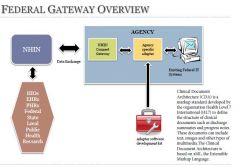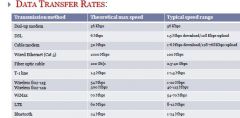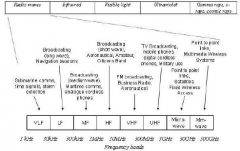![]()
![]()
![]()
Use LEFT and RIGHT arrow keys to navigate between flashcards;
Use UP and DOWN arrow keys to flip the card;
H to show hint;
A reads text to speech;
97 Cards in this Set
- Front
- Back
|
HEALTH INFORMATION EXCHANGE
|
A critical element of Meaningful Use
Essential to improve: The disability process; Continuity of medical care issues; Biosurveillance; Research and natural disaster responses |
|
|
TYPES OF HEALTH-RELATED DATA EXCHANGED
|

|
|
|
Health Information Exchange (HIE)
|
“electronic movement of health-related information among organizations according to nationally recognized standards”
|
|
|
Health Information Organization (HIO)
|
“an organization that oversees and governs the exchange of health-related information among organizations according to nationally recognized standards”.
|
|
|
Regional Health Information Organization (RHIO)
|
“a health information organization that brings together health care stakeholders within a defined geographic area and governs health information exchange among them for the purpose of improving health and care in that community”.
|
|
|
Nationwide Health Information Network History
2004 |
-now called the eHealth exchange
-Bush signed Executive Order 13335 to create ONC -Interoperable electronic health records within the next decade -Release of RFI (Request For Information) |
|
|
Nationwide Health Information Network History
2005 |
NHIN should “be a decentralized architecture built using the Internet linked by uniform communications and a software framework of open standards and policies” and a “network of networks”
|
|
|
NHIN
|
is not a separate network; it is instead a set of standards, services and policies that direct the secure exchange of health information over the Internet Nationwide Health Information Network Exchange now called the eHealth
Exchange |
|
|
ONC
|
Office of the National Coordinator for Health Information Technology
|
|
|
Nationwide Health Information Network History
2006 |
Executive Order 13410 required federal agencies that dealt with health information to select systems capable of meeting national interoperability standards
|
|
|
Nationwide Health Information Network History
2007 |
-HHS releases RFP to participate in phase 2 known as “TRIAL IMPLEMENTATION”
-$22.5 Million – 9 HIOs -CDC awarded contracts to study use of HIOs to support public health information exchange and biosurveillance |
|
|
Nationwide Health Information Network History
2008 |
20 federal agencies would connect to the NHIN, as the “TENTHPARTNER”
|
|
|
Nationwide Health Information Network History
2009 |
-SSA was the 1st federal agency to use NHIN
-Live testing of patient data was completed -NHIN is known as NHIN Exchange -Code for an open source NHIN gateway known as CONNECT was released into the public domain |
|
|
NHIN strategy
|
to establish cross-agency collaboration, develop gateway tools and participate in trial implementations
|
|
|
NHIN gateway known as CONNECT
|
to incentivize and promote adoption of the NHIN by releasing a basic reference implementation of NHIN standard services.
|
|
|
FHA CONNECT consists of three elements:
|
NHIN Gateway
Enterprise Service Component (ESC) The Universal Client Framework |
|
|
NHIN Gateway
|
implements core services like locating patients at other health organizations within the NHIN and requesting and receiving documents associated with the patient.
|
|
|
NHIN Gateway
|
-Authenticating network participants, formulating and evaluating authorizations for the release of medical information and honoring consumer preferences for sharing their information
|
|
|
Enterprise Service Component (ESC)
|
provides enterprise components including a Master Patient Index (MPI), Document Registry and Repository, Authorization Policy Engine, Consumer Preferences Manager, HIPAA-compliant Audit Log and others.
|
|
|
Enterprise Service Component (ESC)
|
Software development kit (SDK) for developing adapters to plug in existing systems such as electronic health records to support exchange of health information across the NHIN
|
|
|
The Universal Client Framework
|
enables agencies to develop end-user applications using the enterprise service components in the ESC
|
|
|
FEDERAL GATEWAY OVERVIEW
|

|
|
|
HEALTH INFORMATION ORGANIZATIONS
NCHIT (2006) Suggestions: part 1 |
-Leverage Internet as foundation and think web-based
-Build on existing successes; take advantage of existing infrastructure |
|
|
HEALTH INFORMATION ORGANIZATIONS
NCHIT (2006) Suggestions: part 2 |
-Have a realistic implementation plan; build incrementally or by phases or module.
-Develop strong physician involvement; involve medical schools and medical societies |
|
|
HEALTH INFORMATION ORGANIZATIONS
NCHIT (2006) Suggestions: part 3 |
-Obtain hospital leadership commitment; much of the information to be shared comes from hospital IT systems
-Do not exclude any stakeholders; HIOs should consist of multiple types of healthcare organizations |
|
|
HEALTH INFORMATION ORGANIZATIONS
NCHIT (2006) Suggestions: part 4 |
-Seek inclusion of local public health officials; the goal is to also develop a public health information network or PHIN
-Obtain support from the business community; vendors who have networking experience will be valuable partners |
|
|
HEALTH INFORMATION ORGANIZATIONS
NCHIT (2006) Suggestions: part 5 |
-Establish a neutral managing partner; a commission or network authority
|
|
|
MODELS OF HIE DATA STORAGE
|
FEDERATED
CENTRALIZED HYBRID |
|
|
MODELS OF HIE DATA STORAGE
FEDERATED |
Data will be stored locally on a server at each network node(hospital, pharmacy or lab). Data therefore has to be shared among the users of the HIO
|
|
|
MODELS OF HIE DATA STORAGE
CENTRALIZED |
HIO operates a central data repository that all entities must access
|
|
|
MODELS OF HIE DATA STORAGE
HYBRID |

A combination of some aspects of federated and centralized model
|
|
|
HEALTH INFORMATION ORGANIZATIONS
|
Insurers (payers); Physicians; Hospitals; Medical societies; Medical schools; Medical Informatics programs; State and local government; Employers; Consumers; Pharmacies and pharmacy networks; Business leaders and selected vendors; Public Health departments
|
|
|
FUNCTIONS NEEDED TO BE ADDRESSED BY HIO
|
Financing; Regulations; Information technology; Clinical process improvements; Incentives; Public relations (PR); Consumer participation
|
|
|
FUNCTIONS NEEDED TO BE ADDRESSED BY HIO part 1
Financing: Regulations: |
-Financing: it will be necessary to obtain short term start up money and a long term business plan to maintain the program
-Regulations: what data, privacy and security standards are going to be used? |
|
|
FUNCTIONS NEEDED TO BE ADDRESSED BY HIO part 2
Information technology: |
who will create and maintain the actual network? Who will do the training? Will the HIO use a centralized or de-centralized data repository?
|
|
|
FUNCTIONS NEEDED TO BE ADDRESSED BY HIO part 3
Clinical process improvements: |
what processes will be selected to improve? Claims submission? Who will monitor and report the progress?
|
|
|
FUNCTIONS NEEDED TO BE ADDRESSED BY HIO part 4
Incentives: Public relations (PR): |
-Incentives: what incentives exist to have disparate forces join?
-Public relations (PR): you need a PR division to get the word out to healthcare workers and the public regarding the potential benefits of creating a HIO |
|
|
FUNCTIONS NEEDED TO BE ADDRESSED BY HIO part 5
Consumer participation: |
in addition to the obvious stakeholders you need input from consumers/patients
|
|
|
STATE OF HEALTH INFORMATION EXCHANGE
part 1 |
73 HIOs operational which 17 have reached the highest level (7) of functionality; Half of operational HIOs charge subscription fees; 18 initiative were termed sustainable; Most HIOs are not ready for Meaningful Use; Opt-out policy most common
|
|
|
STATE OF HEALTH INFORMATION EXCHANGE
part 2 |
Multiple challenges listed: Sustainable business plan, privacy issues, defining value, government mandates, technological issues, governance issues and engaging health plans
|
|
|
STATE OF HEALTH INFORMATION EXCHANGE
part 3 |
-Most common sources of sharable information:
Hospitals, primary care physicians and community/ public health clinics |
|
|
ARCHITECTURES OF INFORMATION SYSTEMS
|
WEB SERVICES
|
|
|
ARCHITECTURES OF INFORMATION SYSTEMS
WEB SERVICES part 1 |
Task specific applications which are deployed in a platform independent manner via a series of transactions to and from other web-aware applications/services over a network (such as the Internet).
|
|
|
ARCHITECTURES OF INFORMATION SYSTEMS
WEB SERVICES part 2 |
Can reduce the cost of converting data with external partners, by allowing for a modular component of a larger system to be invoked with little up front effort.
|
|
|
ARCHITECTURES OF INFORMATION SYSTEMS
WEB SERVICES part 3 |
Two categories:
REPRESENTATIONAL STATE TRANSFER (RESTful) SIMPLE OBJECT ACCESS PROTOCOL (SOAP) |
|
|
ARCHITECTURES OF INFORMATION SYSTEMS
WEB SERVICES REPRESENTATIONAL STATE TRANSFER (RESTful) part 4 |
lightweight services which use existing Internet infrastructure and World Wide Web concepts as their backbone
|
|
|
ARCHITECTURES OF INFORMATION SYSTEMS
WEB SERVICES SIMPLE OBJECT ACCESS PROTOCOL (SOAP) part 5 |
web services utilize a potentially complex series of XML based ontologies to describe and invoke services over a network.
|
|
|
RESTFUL SERVICES part 1
|
-REST, as a concept, is an aggregate description of the functional model of how HTTP allows for the deployment of the WWW over the Internet.
-REST is an architecture, not a standard |
|
|
RESTFUL SERVICES part 2
|
-RESTful service will use XML or JavaScript Object Notation (JSON) for this content delivery.
-RESTful web services require three basic aspects: URI; Operation Type; MIME Type |
|
|
RESTFUL SERVICES part 3
three basic aspects URI |
(Uniform Resource Identifier): a set of characters defining a specific object, resource, or location.
|
|
|
RESTFUL SERVICES part 4
three basic aspects Operation Type |
(GET, DELETE, POST, PUT): these HTTP method scan be extended past their WWW function to provide 4 different points of access to a RESTful service.
|
|
|
RESTFUL SERVICES part 5
three basic aspects MIME Type |
(Multipurpose Internet Mail Extensions): a means of communicating the content type used within a message transferred over the internet.
|
|
|
MIME Type
|
Multipurpose Internet Mail Extensions
|
|
|
URI
|
Uniform Resource Identifier
|
|
|
WEB SERVICES USING SOAP
|
-A protocol standard for interacting with web services.
-Requires a set of standards for content and a service oriented architecture (SOA) stack, a collection of services. |
|
|
WEB SERVICES USING SOAP
Most common standards: |
HTTP, as the internet protocol
XML, as the delivery language |
|
|
XML
|
Extensible Markup Language
|
|
|
HTTP
|
Hypertext Transfer Protocol
|
|
|
WEB SERVICES USING SOAP
SOAP Web services require three basic platform elements: |
SOAP
WSDL UDDI |
|
|
WEB SERVICES USING SOAP
SOAP Web services three basic platform elements: SOAP |
(Simple Object Access Protocol): a communication protocol between applications.
|
|
|
SOAP
|
Simple Object Access Protocol
|
|
|
WEB SERVICES USING SOAP
SOAP Web services three basic platform elements: WSDL |
(Web Services Description Language): a XML document used to describe and locate web services.
|
|
|
WSDL
|
Web Services Description Language
|
|
|
WEB SERVICES USING SOAP
SOAP Web services three basic platform elements: UDDI |
(Universal Description, Discovery and Integration): a directory for storing information about web services, described by WSDL.
|
|
|
UDDI
|
Universal Description, Discovery and Integration
|
|
|
NETWORKS
|
A group of computers that are linked together in order to share information
|
|
|
NETWORKS
DATA TRANSFER RATES: |

|
|
|
INFORMATION TRANSMISSION VIA INTERNET part 1
|
-The INTERNET is the network of choice for transmission of voice, data and images.
-The INTERNET PROTOCOL (IP) is a standard that segments data, voice and video into packets with unique destination addresses. |
|
|
INFORMATION TRANSMISSION VIA INTERNET part 2
|
-ROUTERS read address of packet and forward it towards its destination.
-Transmission performance is affected by the following: Bandwidth; Pack loss; End-to-end delay; Jitter |
|
|
INFORMATION TRANSMISSION VIA INTERNET part 3
Transmission performance affected by following: Bandwidth: Pack loss: |
-Bandwidth: is the size of the pipe to transmit packets
-Pack loss: packets may rarely fail to reach their destination |
|
|
INFORMATION TRANSMISSION VIA INTERNET part 4
Transmission performance affected by following: End-to-end delay: Jitter: |
-End-to-end delay: is latency or delay in receiving a packet
-Jitter: is the random variation in packet delay and reflects Internet spike in activity |
|
|
INFORMATION TRANSMISSION VIA INTERNET part 5
|
Packets travel through Internet. Encryption technique like Federal Information Processing Standard (FIPS) encodes content of each packet so that it can‘t be read while transmitted on the Internet.
|
|
|
FIPS
|
Federal Information Processing Standard
|
|
|
INFORMATION TRANSMISSION VIA INTERNET part 6
|
Encryption, adds some delay and increase in bandwidth requirements.
|
|
|
NETWORK TYPES part 1
|
Networks are named based on connection method, as well as configuration or size.
Personal Area Networks (PANs): Local Area Networks (LANs): |
|
|
NETWORK TYPES part 2
Personal Area Networks |
A PAN is a close proximity network designed to link phones computers, PDAs, etc. The most common technology to create a PAN is BLUETOOTH.
|
|
|
NETWORK TYPES part 3
Local Area Networks (LAN) |
generally refers to linked computers in an office, hospital, home or close proximity situation. LANS can be WIRED or WIRELESS:
|
|
|
NETWORK TYPES part 4
WIRED NETWORKS: |
-Phone lines – connect a computer to the Internet by using a modem
-Power lines – uses standard power outlets to create a network |
|
|
NETWORK TYPES part 5
WIRED NETWORKS: |
-Ethernet – is a network protocol and most networks are connected by fiber or twisted-pair/copper wire connections. Ethernet networks are faster, less expensive and more secure than wireless networks.
|
|
|
NETWORK TYPES part 6
|
WIRELESS (WiFi) NETWORKS (WLANs): are based on the Institute of Electrical and Electronics Engineers (IEEE) 802.11 standard and operate in the 900 MHz, 2.4 GHz and 5 GHz frequencies
|
|
|
NETWORK TYPES part 7
WIRELESS (WiFi) NETWORKS |
Easier to install; Slower than cable and more expensive; 802.11n is the newest standard that can operate at speeds up to 300 Mbps using MIMO or multiple antennas that send and received data much faster and at greater distances
|
|
|
MIMO
|
(Multiple input/multiple output)
|
|
|
RADIO FREQUENCY SPECTRUMS
|

|
|
|
NETWORK TYPES part 8
|
Wide Area Networks (WANs)
Global Area Networks (GANs): |
|
|
NETWORK TYPES part 9
Wide Area Networks |
Cross city, state or national borders. The Internet could be considered a WAN and is often used to connect LANs together.
|
|
|
WAN
|
Wide Area Networks
|
|
|
NETWORK TYPES part 10
Global Area Networks |
GANs are networks that connect other networks and have an unlimited geographic area
|
|
|
GAN
|
Global Area Networks
|
|
|
NETWORK TYPES part 11
Global Area Networks |
-Broadband technology is expensive and the WiFi has spotty coverage that results in which has created a new initiative known as WORLDWIDE INTEROPERABILITY FOR MICROWAVE ACCESS (WiMax) using the IEEE 802.16 standard
|
|
|
WiMax
|
WORLDWIDE INTEROPERABILITY FOR MICROWAVE ACCESS
|
|
|
NETWORK TYPES part 12
Global Area Networks |
-4G network – 10 times faster than 3G
-Permits VOIP -Broadband wireless |
|
|
NETWORK TYPES part 13
Virtual Private Networks |
Virtual Private Networks (VPNs): If a clinician desires access from home to his/her electronic health record, one option is a VPN.
Home computer-client and; work computer you are trying to access is the VPN server. |
|
|
NETWORK TYPES part 14
Virtual Private Networks |
The Internet is the means of connection and VPN will work with wired or wireless LANs.
|
|
|
NETWORK TYPES part 15
Virtual Private Networks |
Authentication and security are key elements of setting up remote access to someone else‘s computer network. “Tunneling protocols” encrypt data by the sender and decrypt it at the receiver‘s end via a secure tunnel.
|
|
|
NETWORK TYPES part 16
Virtual Private Networks |
In addition, the sender‘s and receiver‘s network addresses can be encrypted.
|
|
|
KEY POINTS part 1
|
-Most HIOs use web services and service oriented architecture to exchange health related information
-Clinicians who use client-server based electronic health records need to understand wired or wireless office networks |
|
|
KEY POINTS part 2
|
-Wireless networks have become more attractive due to faster speeds and lower prices
-Wireless broadband is around the corner and will make Internet access faster and more widely available |

